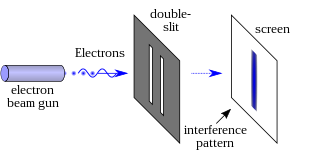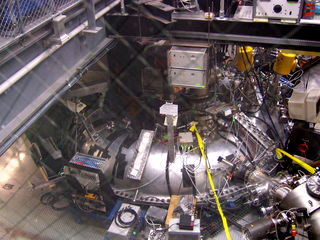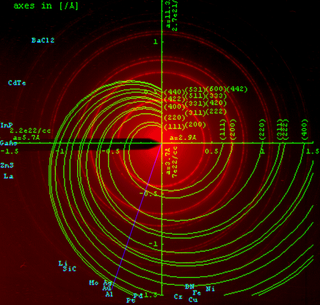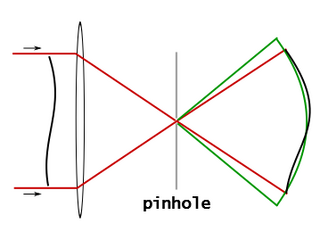An Electron interferometer is an interferometer which interferes the wave function of electrons to make measurements.
An Electron interferometer is an interferometer which interferes the wave function of electrons to make measurements.
Interferometry uses the principal of superposition to make measurements. The electron wave-packet is split into a superposition of two paths. Small differences in the paths will create a phase difference between each portion of the electron superposition. Interfering both halves of the superposition will then create an interference fringe. Measuring this fringe provides a quantifiable means to characterize the interaction strength. Since electrons are charged, they repel each other, thus rendering the theoretical analysis more difficult than for uncharged sources like, e.g., neutrons or atoms. To obtain high precision the de Broglie wavelength needs to be small, which again favors neutrons or (heavy) atoms since they have a higher mass. Therefore, many high precision experiments now deploy atom interferometers based on the Sagnac effect.

In modern physics, the double-slit experiment demonstrates that light and matter can satisfy the seemingly incongruous classical definitions for both waves and particles. This ambiguity is considered evidence for the fundamentally probabilistic nature of quantum mechanics. This type of experiment was first performed by Thomas Young in 1801, as a demonstration of the wave behavior of visible light. In 1927, Davisson and Germer and, independently George Paget Thomson and his research student Alexander Reid demonstrated that electrons show the same behavior, which was later extended to atoms and molecules. Thomas Young's experiment with light was part of classical physics long before the development of quantum mechanics and the concept of wave–particle duality. He believed it demonstrated that Christiaan Huygens' wave theory of light was correct, and his experiment is sometimes referred to as Young's experiment or Young's slits.

In physics, interference is a phenomenon in which two coherent waves are combined by adding their intensities or displacements with due consideration for their phase difference. The resultant wave may have greater intensity or lower amplitude if the two waves are in phase or out of phase, respectively. Interference effects can be observed with all types of waves, for example, light, radio, acoustic, surface water waves, gravity waves, or matter waves as well as in loudspeakers as electrical waves.

Interferometry is a technique which uses the interference of superimposed waves to extract information. Interferometry typically uses electromagnetic waves and is an important investigative technique in the fields of astronomy, fiber optics, engineering metrology, optical metrology, oceanography, seismology, spectroscopy, quantum mechanics, nuclear and particle physics, plasma physics, biomolecular interactions, surface profiling, microfluidics, mechanical stress/strain measurement, velocimetry, optometry, and making holograms.
Matter waves are a central part of the theory of quantum mechanics, being half of wave–particle duality. At all scales where measurements have been practical, matter exhibits wave-like behavior. For example, a beam of electrons can be diffracted just like a beam of light or a water wave.
In physics, coherence expresses the potential for two waves to interfere. Two monochromatic beams from a single source always interfere. Physical sources are not strictly monochromatic: they may be partly coherent. Beams from different sources are mutually incoherent.

The Mach–Zehnder interferometer is a device used to determine the relative phase shift variations between two collimated beams derived by splitting light from a single source. The interferometer has been used, among other things, to measure phase shifts between the two beams caused by a sample or a change in length of one of the paths. The apparatus is named after the physicists Ludwig Mach and Ludwig Zehnder; Zehnder's proposal in an 1891 article was refined by Mach in an 1892 article. Mach–Zehnder interferometry with electrons as well as with light has been demonstrated. The versatility of the Mach–Zehnder configuration has led to its being used in a range of research topics efforts especially in fundamental quantum mechanics.
An atom interferometer uses the wave-like nature of atoms in order to produce interference. In atom interferometers, the roles of matter and light are reversed compared to the laser based interferometers, i.e. the beam splitter and mirrors are lasers while the source emits matter waves rather than light. Atom interferometers measure the difference in phase between atomic matter waves along different paths. Matter waves are controlled an manipulated using systems of lasers. Atom interferometers have been used in tests of fundamental physics, including measurements of the gravitational constant, the fine-structure constant, and universality of free fall. Applied uses of atom interferometers include accelerometers, rotation sensors, and gravity gradiometers.

In physics, a neutron interferometer is an interferometer capable of diffracting neutrons, allowing the wave-like nature of neutrons, and other related phenomena, to be explored.
The interferometric visibility is a measure of the contrast of interference in any system subject to wave superposition. Examples include as optics, quantum mechanics, water waves, sound waves, or electrical signals. Visibility is defined as the ratio of the amplitude of the interference pattern to the sum of the powers of the individual waves. The interferometric visibility gives a practical way to measure the coherence of two waves. A theoretical definition of the coherence is given by the degree of coherence, using the notion of correlation.

The Madison Symmetric Torus (MST) is a reversed field pinch (RFP) physics experiment with applications to both fusion energy research and astrophysical plasmas.

Powder diffraction is a scientific technique using X-ray, neutron, or electron diffraction on powder or microcrystalline samples for structural characterization of materials. An instrument dedicated to performing such powder measurements is called a powder diffractometer.
Lloyd's mirror is an optics experiment that was first described in 1834 by Humphrey Lloyd in the Transactions of the Royal Irish Academy. Its original goal was to provide further evidence for the wave nature of light, beyond those provided by Thomas Young and Augustin-Jean Fresnel. In the experiment, light from a monochromatic slit source reflects from a glass surface at a small angle and appears to come from a virtual source as a result. The reflected light interferes with the direct light from the source, forming interference fringes. It is the optical wave analogue to a sea interferometer.

A point diffraction interferometer (PDI) is a type of common-path interferometer. Unlike an amplitude-splitting interferometer, such as a Michelson interferometer, which separates out an unaberrated beam and interferes this with the test beam, a common-path interferometer generates its own reference beam. In PDI systems, the test and reference beams travel the same or almost the same path. This design makes the PDI extremely useful when environmental isolation is not possible or a reduction in the number of precision optics is required. The reference beam is created from a portion of the test beam by diffraction from a small pinhole in a semitransparent coating. The principle of a PDI is shown in Figure 1.
Hardy's paradox is a thought experiment in quantum mechanics devised by Lucien Hardy in 1992–1993 in which a particle and its antiparticle may interact without annihilating each other.

A white light scanner (WLS) is a device for performing surface height measurements of an object using coherence scanning interferometry (CSI) with spectrally-broadband, "white light" illumination. Different configurations of scanning interferometer may be used to measure macroscopic objects with surface profiles measuring in the centimeter range, to microscopic objects with surface profiles measuring in the micrometer range. For large-scale non-interferometric measurement systems, see structured-light 3D scanner.
Length measurement, distance measurement, or range measurement (ranging) refers to the many ways in which length, distance, or range can be measured. The most commonly used approaches are the rulers, followed by transit-time methods and the interferometer methods based upon the speed of light.
A common-path interferometer is a class of interferometers in which the reference beam and sample beams travel along the same path. Examples include the Sagnac interferometer, Zernike phase-contrast interferometer, and the point diffraction interferometer. A common-path interferometer is generally more robust to environmental vibrations than a "double-path interferometer" such as the Michelson interferometer or the Mach–Zehnder interferometer. Although travelling along the same path, the reference and sample beams may travel along opposite directions, or they may travel along the same direction but with the same or different polarization.
Ramsey interferometry, also known as the separated oscillating fields method, is a form of particle interferometry that uses the phenomenon of magnetic resonance to measure transition frequencies of particles. It was developed in 1949 by Norman Ramsey, who built upon the ideas of his mentor, Isidor Isaac Rabi, who initially developed a technique for measuring particle transition frequencies. Ramsey's method is used today in atomic clocks and in the SI definition of the second. Most precision atomic measurements, such as modern atom interferometers and quantum logic gates, have a Ramsey-type configuration. A more modern method, known as Ramsey–Bordé interferometry uses a Ramsey configuration and was developed by French physicist Christian Bordé and is known as the Ramsey–Bordé interferometer. Bordé's main idea was to use atomic recoil to create a beam splitter of different geometries for an atom-wave. The Ramsey–Bordé interferometer specifically uses two pairs of counter-propagating interaction waves, and another method named the "photon-echo" uses two co-propagating pairs of interaction waves.
In quantum mechanics, the quantum Cheshire cat is a quantum phenomena that suggests that a particle's physical properties can take a different trajectory from that of the particle itself. The name makes reference to the Cheshire Cat from Lewis Carroll's Alice's Adventures in Wonderland, a feline character which could disappear leaving only its grin behind. The effect was originally proposed by Yakir Aharonov, Daniel Rohrlich, Sandu Popescu and Paul Skrzypczyk in 2012.
In physics, the gravitational Aharonov-Bohm effect is a phenomenon involving the behavior of particles acting according to quantum mechanics while under the influence of a classical gravitational field. It is the gravitational analog of the well-known Aharonov–Bohm effect, which is about the quantum mechanical behavior of particles in a classical electromagnetic field.